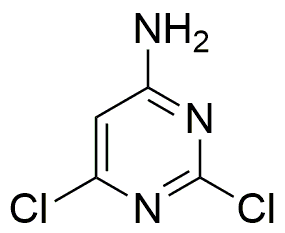4-Amino-2,6-dichloropyrimidine is widely utilized in research focused on:
- Agricultural Chemistry: This compound serves as a key intermediate in the synthesis of herbicides, helping to develop effective solutions for weed management in crops.
- Pharmaceutical Development: It plays a crucial role in the production of antiviral and anticancer agents, contributing to the development of new therapies for various diseases.
- Material Science: Used in the formulation of polymers and resins, it enhances the properties of materials, making them more durable and resistant to environmental factors.
- Biochemistry: This chemical is important in the synthesis of nucleic acid analogs, which are vital for studying genetic materials and developing molecular biology techniques.
- Analytical Chemistry: It is utilized as a reagent in various analytical methods, aiding researchers in the detection and quantification of other compounds in complex mixtures.
General Information
Properties
Safety and Regulations
Applications
4-Amino-2,6-dichloropyrimidine is widely utilized in research focused on:
- Agricultural Chemistry: This compound serves as a key intermediate in the synthesis of herbicides, helping to develop effective solutions for weed management in crops.
- Pharmaceutical Development: It plays a crucial role in the production of antiviral and anticancer agents, contributing to the development of new therapies for various diseases.
- Material Science: Used in the formulation of polymers and resins, it enhances the properties of materials, making them more durable and resistant to environmental factors.
- Biochemistry: This chemical is important in the synthesis of nucleic acid analogs, which are vital for studying genetic materials and developing molecular biology techniques.
- Analytical Chemistry: It is utilized as a reagent in various analytical methods, aiding researchers in the detection and quantification of other compounds in complex mixtures.
Documents
Safety Data Sheets (SDS)
The SDS provides comprehensive safety information on handling, storage, and disposal of the product.
Product Specification (PS)
The PS provides a comprehensive breakdown of the product’s properties, including chemical composition, physical state, purity, and storage requirements. It also details acceptable quality ranges and the product's intended applications.
Certificates of Analysis (COA)
Search for Certificates of Analysis (COA) by entering the products Lot Number. Lot and Batch Numbers can be found on a product’s label following the words ‘Lot’ or ‘Batch’.
*Catalog Number
*Lot Number
Certificates Of Origin (COO)
This COO confirms the country where the product was manufactured, and also details the materials and components used in it and whether it is derived from natural, synthetic, or other specific sources. This certificate may be required for customs, trade, and regulatory compliance.
*Catalog Number
*Lot Number
Safety Data Sheets (SDS)
The SDS provides comprehensive safety information on handling, storage, and disposal of the product.
DownloadProduct Specification (PS)
The PS provides a comprehensive breakdown of the product’s properties, including chemical composition, physical state, purity, and storage requirements. It also details acceptable quality ranges and the product's intended applications.
DownloadCertificates of Analysis (COA)
Search for Certificates of Analysis (COA) by entering the products Lot Number. Lot and Batch Numbers can be found on a product’s label following the words ‘Lot’ or ‘Batch’.
*Catalog Number
*Lot Number
Certificates Of Origin (COO)
This COO confirms the country where the product was manufactured, and also details the materials and components used in it and whether it is derived from natural, synthetic, or other specific sources. This certificate may be required for customs, trade, and regulatory compliance.


